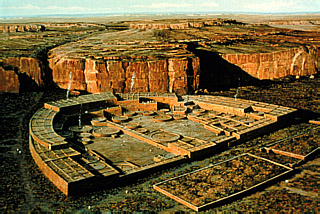Mesa Verde is where the Anastazi Puebloans built their famous Cliff Dwellings, into the side of the cliffs. Seventy miles to the South East the Chaco Puebloans had already built a complex series of villages in the middle of the desert.
The central pueblo is called Pueblo Benito, from the air it is a neatly symmetrical D shaped village. This was the administrative, social and religious capital of their culture.
The unique feature of a pueblo is that the village is built almost as a single building, with hundreds of rooms which join on, either to the side or above and below, to each other. It is almost like life sized Lego, each room seems to be fixed to several others. At the centre of the Pueblo the building may be five stories high (at Benito anyway). As many as fifteen hundred people would live in a single Pueblo, perhaps each family had a room, though many rooms for other purposes than dwellings. Archeologists have found many other uses that the rooms were put to. Many of the rooms were for religious purposes, they are usually round and called Kivas. These rooms were either built round, or originally built square and had circular curtain walls added to them. The Chaco Pueblo builders had a similar level of masonry skill to builders of Europe, who were of the same era, between 900 and 1300 A.D. Their principle building system was the veneer wall, this being two thin layers of carefully placed stone, with the space in between being filled with rubble, just to give it bulk. exactly the same process was used in Europe to build castles and cathedrals. One major difference was that Puebloans did not seem to have discovered the concept of the arch. Although the rooms in a pueblo are usually quite small, with very few being more than 15 feet square, their Big Kivas are much bigger, being a circular room, dug into the ground, which was covered by a roof. Some of the kivas were 80ft across. The roofs were usually made from timber, held up by four pillars. Quite a clever construction. |
| Pueblo Benito as it looks now |
 |
| As it probably looked in 1200A.D. |
This was a very exciting day, which we enjoyed immensely.
good to see they haven't built any more in this village!!
ReplyDeleteThis comment has been removed by the author.
ReplyDelete